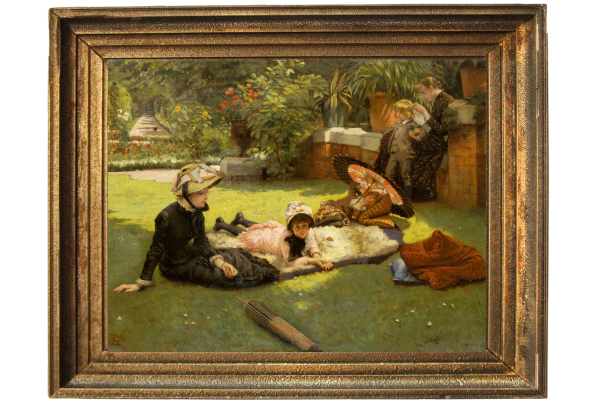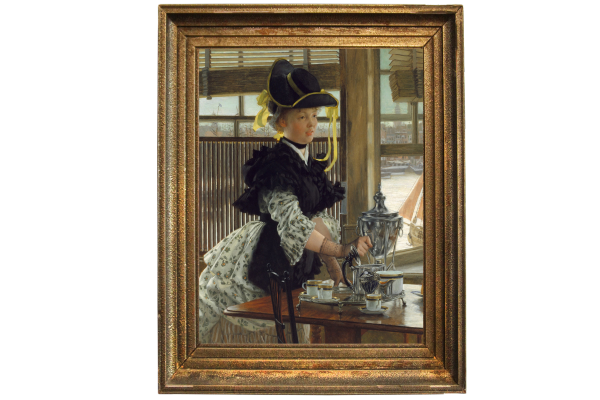James Tissot (1836-1902), a distinguished French painter and illustrator, was celebrated for his unique style and exceptional ability to capture the nuances of human experiences. A considerable portion of his career was spent in London, where his work gained popularity and evolved in response to the city’s dynamic art scene. In this article, we delve into Tissot’s time in London, the places he called home, and his iconic painting “Tea,” which illustrates the city’s influence on his art.
James Tissot’s Arrival in London
In 1871, following the devastation of the Franco-Prussian War and the collapse of the Paris Commune, French artist James Tissot made the courageous decision to leave his homeland and start afresh in London. The British capital offered Tissot a myriad of new opportunities, as well as the chance to establish himself in a stimulating and diverse environment. Tissot quickly integrated into London’s flourishing artistic community, forging connections and collaborating with esteemed publications such as Vanity Fair. Furthermore, he began to create genre paintings featuring the River Thames as their backdrop, showcasing the city’s distinctive charm and character.
Tissot formed relationships with prominent British artists, collectors, and patrons, as well as fellow expatriate French artists who had also sought refuge in the UK. Through these connections, Tissot gained invaluable insight into the complexities of British society, which would inspire and inform much of his artistic output during his time in the country.
In addition to his work with Vanity Fair, Tissot explored various ways to incorporate elements of British culture and society into his paintings. His London-based works often depicted scenes of everyday life, capturing intimate moments and social interactions among the city’s elite. Many of these paintings, such as those featuring the River Thames, showcased Tissot’s keen eye for detail and his ability to convey the atmosphere of a particular place and time.
Through his genre paintings, Tissot celebrated the unique qualities of London and its people, highlighting the city’s rich history and bustling contemporary life. In doing so, he managed to capture the essence of a city undergoing rapid change, while still paying homage to its storied past. This approach deeply resonated with British audiences, who appreciated Tissot’s sensitive and nuanced portrayal of their homeland.
London Residences
During his time in London, Tissot resided in two notable locations. Initially, Tissot settled at 17 Grove End Road (now renumbered as 44), where he rented a spacious house complete with a large garden and studio. The studio was a crucial feature for Tissot, as it allowed him to continue producing his artwork and refining his skills in his new environment.
In 1875, Tissot relocated to an even more spacious residence at 73 Springfield Road, in St. John’s Wood. Here, he would reside until he left London in 1882. This impressive house provided Tissot with the space and comfort needed to fully immerse himself in his work and the city’s artistic scene.

St. John’s Wood: A Hub for Artistic Talent
During the latter half of the 19th century, St. John’s Wood became a popular area for artists to live and work. Tissot was among the many painters who established themselves in this vibrant neighbourhood, which was known for its picturesque streets and lush gardens. St. John’s Wood’s appeal as a residential area for artists was due in part to its proximity to central London and the Royal Academy of Arts, as well as its affordable housing and spacious studios.
The artistic community in St. John’s Wood during Tissot’s time was incredibly diverse and dynamic. Many prominent artists of the era, both British and international, called this area home. Some notable names include Philip Hermogenes Calderon, a British painter of French and Spanish descent; Frank Holl, a social realist painter known for his scenes of urban life; and Lawrence Alma-Tadema, a Dutch painter famous for his depictions of ancient Rome.
The St. John’s Wood Clique, a group of artists known for their genre paintings and commitment to realism, was another influential artistic community in the area. Members of the clique included artists such as George Adolphus Storey, Frederick Walker, and Henry Stacy Marks, who often gathered to discuss art, collaborate on projects, and provide mutual support and inspiration.
Tissot’s success as an artist and his ability to establish a strong reputation in the London art scene served as an inspiration for other artists in St. John’s Wood. He demonstrated that it was possible for an expatriate artist to gain recognition and acclaim in a foreign city, and his example paved the way for other international artists to pursue their careers in London.
The influence of the artistic community in St. John’s Wood is evident in Tissot’s work, particularly in his focus on domestic scenes and everyday life. The lively exchange of ideas and styles between the artists living in the area helped shape Tissot’s approach to painting and allowed him to develop his unique style, which combined elements of French and British artistic traditions.
Both of Tissot’s London homes served as sources of inspiration for his artwork, as they allowed him to observe and capture the essence of Victorian high society. These residences were more than just places where Tissot lived and worked; they became social hubs where he hosted gatherings and entertained influential figures from the art world, such as Edgar Degas, Édouard Manet, and James Whistler. By opening his home to these distinguished guests, Tissot fostered an environment that encouraged artistic collaboration and intellectual exchange.
These social events allowed Tissot to engage with the London art scene, deepening his understanding of British culture and society. The intimate gatherings held at his residences offered Tissot the opportunity to study and capture the unique customs, fashions, and interactions of the time, which would ultimately inform his genre paintings.

The Painting “Tea”
Created during Tissot’s time in London, “Tea” is a reimagining of the left-hand portion of another one of his celebrated works, “Bad News” (National Museum of Wales, Cardiff). “Bad News” features a naval captain and his girlfriend grappling with the reality of his impending departure, while a companion attends to the preparation of tea. The scene is set against the evocative backdrop of the Pool of London.
In “Tea,” Tissot shifts the focus to the dense cityscape that lies beyond the stretch of the river. This change in perspective allows Tissot to explore and highlight the intricacies of Victorian society, specifically the rituals and customs associated with the British pastime of tea drinking.
Artistic Techniques in “Tea”
Tissot’s exceptional technique is on full display in “Tea.” He employs a delicate colour palette and intricate brushwork to bring the scene to life, capturing the minute details of the subjects’ clothing and surroundings with almost photographic precision. This keen attention to detail lends the painting a sense of realism that immerses the viewer in the world of Victorian London.
Tissot’s Legacy and “Tea”
“Tea” is a shining example of Tissot’s extraordinary talent and his ability to capture the spirit of an era. The painting is not only a testament to Tissot’s artistic skill but also a valuable record of the customs, fashions, and social dynamics that defined Victorian London. As we look back on the works of James Tissot, “Tea” stands out as a captivating portrayal of the world that once was, offering a timeless tribute to a bygone era and the city that inspired it. not only showcases Tissot’s artistic prowess but also provides a fascinating glimpse into the customs and social interactions of the Victorian era. Tissot’s friend and fellow artist, Edgar Degas, was an admirer of this work and even owned a pencil study for it. This speaks to the painting’s impact on the art world and its enduring appeal.
The Influence of London on Tissot’s Art
Tissot’s exploration of British culture extended beyond the opulent drawing rooms of the upper class. He ventured outdoors, painting numerous scenes set along the River Thames. These works depicted the bustling river life, the distinctive cityscape, and the unique atmosphere that characterised London during the Victorian era. Through his art, Tissot created a visual chronicle of the city that resonates with viewers to this day, offering valuable insights into London’s history, culture, and spirit.
One of the most striking aspects of Tissot’s work during his time in London is his focus on the city’s inhabitants. He was particularly interested in the lives of women, often featuring them as the central subjects of his paintings. Tissot meticulously depicted the diverse range of roles, emotions, and experiences that women of the time encountered, offering a more complex and nuanced portrayal of Victorian womanhood than was typically seen in the art of the period.
Another facet of Tissot’s work that was heavily influenced by his time in London is his exploration of the leisure activities and pastimes of the city’s residents. In addition to the ritual of tea drinking, Tissot’s paintings captured other popular pursuits of the time, such as attending the theatre, boating on the Thames, and visiting public gardens. These works provide a fascinating insight into how people of the Victorian era spent their leisure time and how they engaged with the urban environment around them.
Moreover, Tissot’s experience in London allowed him to develop a deep understanding of British fashion, which he incorporated into his art. The artist became known for his meticulous attention to the clothing of his subjects, capturing the textures, patterns, and colours of the fabrics with incredible accuracy. His portrayal of fashion trends and the clothing worn by London’s high society has left a lasting impression on the art world and continues to serve as a valuable resource for fashion historians.
Tissot’s Legacy in London
During his London years, Tissot gained recognition for his distinctive style, characterised by a delicate colour palette, intricate brushwork, and near-photographic precision. His portrayal of fashionable women, often adorned in meticulously rendered clothing, became a hallmark of his work. Tissot’s paintings not only captured the beauty of his subjects but also provided a window into the world of Victorian high society, with its complex social codes and rituals.
Beyond the confines of the art world, Tissot’s influence extended to the fashion trends of the era. His paintings were admired by designers and tastemakers who looked to Tissot’s depictions of stylish women as a source of inspiration for their own creations. Through his artwork, Tissot made a lasting impact on the aesthetics of the time, shaping the way people dressed and presented themselves.
Tissot’s Tea is at the Metropolitan Museum of Art, New York.
Learn about the history of Afternoon Tea




